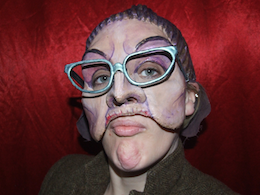“An léigh tú an bleedin' dráma?”
Máiréad Ní Ghráda's 1964 drama has been on the Leaving Certificate Irish curriculum for the last sixteen years, but Fíbín Teo's production brings the seemingly outdated plot into the context of modern society, using puppets, masks, and music to appeal particularly to a younger audience, making it current and more accessible. An Triail tells the story of Máire Ní Chathasaigh, a young woman who falls for the charms of married schoolteacher Pádraig Mac Cárthaigh, eventually finding herself pregnant with his child. The play centres around the theme of the hypocrisy of 1960s Catholic Ireland in relation to illegitimate children and its responsibility for the ultimate death of both Máire and her baby, and this is brought to the fore in Fíbín Teo's production.
 The production is clearly targeted at a teenage audience, in particular those studying the play for their Leaving Cert, as subtle changes in the language of the text as well as music and acting choices make the characters engaging and current. The audience is invited to participate in the drama from the beginning when a newsreader comes through the audience telling us of the “tragóid uafásach”, targeting individual audience members when he asks “an léigh tú an bleedin' dráma?” Similarly, the play's main themes are emphasised by the use of dramatic lighting by John Comiskey and director Brendan Murray's character and movement choices which are sometimes of an almost pantomimic quality. Bean Uí Chathasaigh is a typical Irish mammy, complete with rosary beads, the hypocrisy of which is highlighted in the scene where she first discovers that her daughter is pregnant. The use of red lighting and silhouette in this moment, while effective in accentuating the mother's violence, is perhaps a little forced.
The production is clearly targeted at a teenage audience, in particular those studying the play for their Leaving Cert, as subtle changes in the language of the text as well as music and acting choices make the characters engaging and current. The audience is invited to participate in the drama from the beginning when a newsreader comes through the audience telling us of the “tragóid uafásach”, targeting individual audience members when he asks “an léigh tú an bleedin' dráma?” Similarly, the play's main themes are emphasised by the use of dramatic lighting by John Comiskey and director Brendan Murray's character and movement choices which are sometimes of an almost pantomimic quality. Bean Uí Chathasaigh is a typical Irish mammy, complete with rosary beads, the hypocrisy of which is highlighted in the scene where she first discovers that her daughter is pregnant. The use of red lighting and silhouette in this moment, while effective in accentuating the mother's violence, is perhaps a little forced.

The set, designed by Pete Nelson, is deceptively basic, but is creatively transformed into a bedroom, a kitchen and, ultimately, a graveyard. The dull, drabness of the set and the grey floor slabs carry a sense of doom throughout the play, creating an atmosphere of entrapment and hopelessness. The two monstrous
barrister puppets overshadow the drama, and offer commentary throughout, reminiscent in a way of Muppets characters Statler and Waldorf, although perhaps a touch less witty!
The masks and puppets, superbly crafted by Matthew Guinnane, are the real stars of the show and are brought to life by the wonderfully talented cast. Hilarious caricatures are created which not only entertain the audience, but also, coupled with the half-costumes designed by Blánaid Ní Nuanáin, serve as a literal representation of the masks worn by the characters in the play in their condemnation of Máire's plight in the name of Christianity. Significantly, Máire is the only character not wearing a mask, but it is unclear as to why Mailí wears one, as she is the only genuine character who shows Máire kindness.
Actors Eoin Mac Diarmada and Ray Cudihay stand out in their comic portrayal of the few female characters who were played in drag, and in particular the hilarious yet disturbingly sleazy Colm Ó Sé, whose ever-protruding tongue is the cause of much amusement among the audience.
A creative and vibrant interpretation of Máiréad Ní Ghráda's play.
Helen Cusack has a BA in Drama Studies and Masters in Children's Literature from Trinity College Dublin.